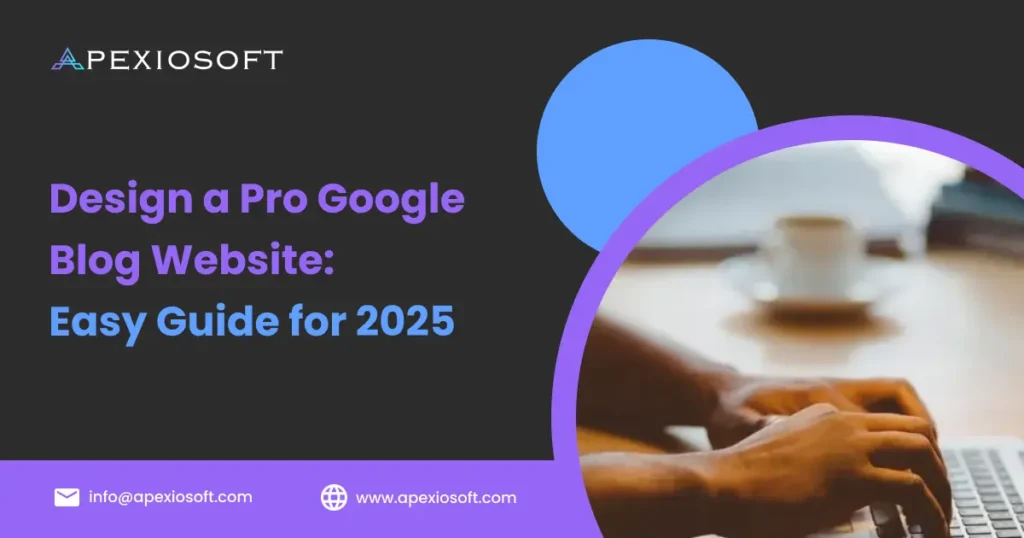In 2025, having a professional online presence is no longer optional—it’s essential. Whether you’re a content creator, small business owner, or hobbyist, a well-designed blog can boost your credibility, audience trust, and search engine rankings. But here’s the thing—you don’t need to spend a fortune or learn coding to build a beautiful blog.
Welcome to Apexiosoft’s ultimate guide on how to design a professional-looking Google Blog website using Blogger (Blogspot)—Google’s free and beginner-friendly blogging platform. This step-by-step blog is packed with visuals, SEO strategies, template hacks, and UX tips to make your blog pop in 2025.
1. Why Choose Google Blogger for Your Blog Website
It’s Free and Beginner-Friendly
You can start your blog today without spending a dime. Google Blogger offers free hosting, free templates, and easy integration with other Google services.
SEO-Optimized by Default
Since Blogger is a Google product, it’s already structured to be indexed and ranked well in Google search results.
Google AdSense Integration
You can monetize your blog easily with built-in AdSense support.
Question: best blogging platform for beginners in 2025
2. Pick a Niche and Define Your Brand Style
Before you start designing, clarify your blog’s niche and visual identity.
Ask Yourself:
- What’s my blog about?
- Who’s my target audience?
- What vibe or aesthetic do I want to give off? (Minimalist, colorful, elegant, etc.)
Branding Tip from Apexiosoft: Keep a consistent color palette, use 1-2 signature fonts, and create a logo using Canva or Looka.
Question: how to create a blog brand identity for google blog website?
3. Set Up Your Google Blog Website
Step-by-Step:
- Go to www.blogger.com
- Sign in using your Google account.
- Click “New Blog.”
- Choose your blog title and URL.
- Select a starter template (we’ll customize it next).
Pro Tip: Choose a short, keyword-rich domain name that matches your niche.
Question: how to set up a google blog website with custom domain?
4. Choose the Right Template (and Customize It Like a Pro)
Top 3 Free Responsive Templates for 2025:
- Contempo
- Soho
- Emporio
Customization Checklist:
- Header & Logo
- Navigation Bar
- Background & Colors
- Post Layout Style
- Footer Widgets
Question: best free responsive templates for google blog website 2025
5. Use a Custom Domain Name
A custom domain adds instant credibility.
Example:
From: yourblog.blogspot.com To: www.yourblog.com
How to Do It:
- Buy a domain from Google Domains or Namecheap.
- Go to Blogger > Settings > Publishing > Custom Domain.
- Follow the DNS setup instructions.
Question: how to connect custom domain to google blog website?
6. Design Mobile-Friendly Layouts
Why It Matters:
- Over 70% of users visit blogs from mobile devices.
- Google ranks mobile-optimized sites higher.
Design Tips:
- Use large readable fonts
- Keep navigation simple
- Ensure images are responsive
Question: how to make google blog mobile responsive design?
7. Add Custom Fonts and Styling with CSS
How to Add Custom Fonts:
- Go to Blogger > Theme > Customize > Advanced.
- Use the font picker or add custom CSS.
CSS Styling Example:
.post-title {
font-family: 'Poppins', sans-serif;
color: #222;
}
Question: custom css code for google blog website design
8. Design a Professional Homepage
A homepage is your blog’s storefront. Make it inviting.
Sections to Include:
- Hero Banner with your tagline
- Recent Posts
- About Section
- Call to Action (Subscribe, Contact, etc.)
Question: how to create homepage for google blog website in blogger?
9. Add High-Quality Visuals
Tools to Use:
- Canva for blog banners
- Unsplash & Pexels for free stock photos
Optimization Tips:
- Compress images with TinyPNG
- Use consistent image sizes
- Add ALT text for SEO
Question: how to use visuals for google blog website seo boost?
10. Improve User Experience (UX)
UX Best Practices:
- Fast loading times
- Easy navigation
- Clear CTA buttons
Tip from Apexiosoft: Conduct user testing with 3-5 friends and gather feedback before launching.
Question: how to improve user experience in google blogger website?
11. Install Essential Widgets
Widgets can level up your blog’s functionality.
Must-Have Widgets:
- Search Bar
- Popular Posts
- Newsletter Signup
- Categories/Labels
- Contact Form
Question: top widgets for professional google blog website
12. Optimize for SEO
On-Page SEO Checklist:
- Use keyword-rich blog titles
- Include internal and external links
- Use headings (H1, H2, H3) properly
- Add meta descriptions for each post
Tools:
- Google Search Console
- Ubersuggest for keywords
- Grammarly for readability
Question: how to do on-page seo for google blog website?
13. Set Up Google Analytics and Search Console
Why:
Track your blog’s traffic, audience behavior, and performance.
Steps:
- Create a Google Analytics account
- Add the tracking ID in Blogger > Settings > Analytics
- Connect your blog to Google Search Console
Question: how to connect google analytics with blogger site 2025?
14. Create a Content Calendar & Start Posting
Consistency = Growth.
Tips:
- Publish 1-2 posts per week
- Use Google Calendar or Notion to plan topics
- Write around long-tail keywords like: how to start a fashion blog on google blogger
Final Thoughts
Designing a professional-looking Google Blog website is totally doable—even if you’re not a designer or developer. By following this detailed guide, you’re not just launching a blog, you’re building an online brand.
At Apexiosoft, we help creatives, solopreneurs, and small businesses build optimized, aesthetic, and growth-ready digital presences. If you’re ready to level up your blog’s design or need a custom Blogger template, hit us up today.
Need help with your blog design? DM us or visit us for custom blog design solutions. 🚀


